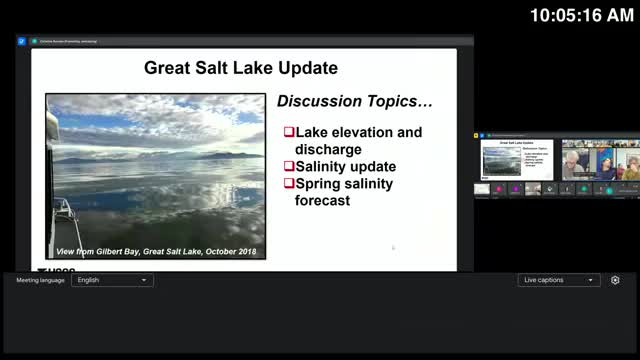Great Salt Lake salinity easing but mass still high; winter–spring forecasts show continued northward export
January 25, 2025 | Utah Great Salt Lake Advisory Council, Boards and Commissions, Organizations, Utah Executive Branch, Utah

This article was created by AI summarizing key points discussed. AI makes mistakes, so for full details and context, please refer to the video of the full meeting. Please report any errors so we can fix them. Report an error »

The Utah Great Salt Lake salinity and hydrology teams reported that both arms of the lake have risen from seasonal lows but the south arm still holds large quantities of salt mass that are being exported north through the causeway breach.
“We were sitting at about point, 6 feet,” and “the daily value at the South Arm gauge on 21st of this month was 4192.6 feet,” U.S. Geological Survey hydrologist Ryan Rolland said, summarizing recent gauge and discharge measurements.
The presenters combined repeated in‑lake salinity samples and discharge records at the new breach to estimate a current south‑arm salt mass of about 885,000,000 tons and a net south→north export since mid‑2023 of roughly 230,000,000 tons, Christine Ramsey of the Utah Geological Survey said. Ramsey and Rolland said those two independent lines of evidence were in agreement, which the teams said increases confidence in the flux estimates.
Measured discharges at the breach and lakeside stations were summarized for recent months: field measurements included 823 cubic feet per second (CFS) south→north on Oct. 4, 2024; 829 CFS on Nov. 20; 803 CFS on Dec. 5; and 1,080 CFS on Jan. 10 (south→north), with smaller, intermittent north→south flows recorded separately. Rolland noted that some sites lost an instantaneous continuous rating in mid‑2024 because of backwater effects and that technicians continue to make monthly field measurements.
Ramsey presented a set of scenario forecasts through June and out to October that used recent observed fluxes and simple climatic scenarios (wet/cool, average, dry/warm). Under typical and wet scenarios the south arm salinity and mass trend lower by fall; under dry scenarios salinity stays higher. The models show a wide spread because the primary driver is annual climate and the timing and magnitude of north→south exchange through the causeway.
The teams emphasized monitoring gaps that limit precision. They recommended expanded and higher‑frequency sampling around the breach and at lakeside to capture rapid temporal changes and to better validate hydrodynamic and flux models.
The committee discussed ecological sensitivity during lower‑salinity episodes (for example potential effects on brine shrimp and waterfowl food webs) and asked for further work to link seasonal biological vulnerability windows to forecast outputs. The presenters said that more frequent water‑column salinity profiling at the breach would help refine short‑term predictions and ecological risk assessments.
Looking ahead, the presenters said the state will use the forecasts and updated flux calculations to inform conversations about causeway operations and other management options as they relate to salt mass and salinity targets.
“We were sitting at about point, 6 feet,” and “the daily value at the South Arm gauge on 21st of this month was 4192.6 feet,” U.S. Geological Survey hydrologist Ryan Rolland said, summarizing recent gauge and discharge measurements.
The presenters combined repeated in‑lake salinity samples and discharge records at the new breach to estimate a current south‑arm salt mass of about 885,000,000 tons and a net south→north export since mid‑2023 of roughly 230,000,000 tons, Christine Ramsey of the Utah Geological Survey said. Ramsey and Rolland said those two independent lines of evidence were in agreement, which the teams said increases confidence in the flux estimates.
Measured discharges at the breach and lakeside stations were summarized for recent months: field measurements included 823 cubic feet per second (CFS) south→north on Oct. 4, 2024; 829 CFS on Nov. 20; 803 CFS on Dec. 5; and 1,080 CFS on Jan. 10 (south→north), with smaller, intermittent north→south flows recorded separately. Rolland noted that some sites lost an instantaneous continuous rating in mid‑2024 because of backwater effects and that technicians continue to make monthly field measurements.
Ramsey presented a set of scenario forecasts through June and out to October that used recent observed fluxes and simple climatic scenarios (wet/cool, average, dry/warm). Under typical and wet scenarios the south arm salinity and mass trend lower by fall; under dry scenarios salinity stays higher. The models show a wide spread because the primary driver is annual climate and the timing and magnitude of north→south exchange through the causeway.
The teams emphasized monitoring gaps that limit precision. They recommended expanded and higher‑frequency sampling around the breach and at lakeside to capture rapid temporal changes and to better validate hydrodynamic and flux models.
The committee discussed ecological sensitivity during lower‑salinity episodes (for example potential effects on brine shrimp and waterfowl food webs) and asked for further work to link seasonal biological vulnerability windows to forecast outputs. The presenters said that more frequent water‑column salinity profiling at the breach would help refine short‑term predictions and ecological risk assessments.
Looking ahead, the presenters said the state will use the forecasts and updated flux calculations to inform conversations about causeway operations and other management options as they relate to salt mass and salinity targets.
View full meeting
This article is based on a recent meeting—watch the full video and explore the complete transcript for deeper insights into the discussion.
View full meeting

